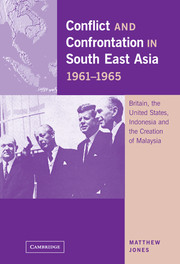 Conflict and Confrontation in South East Asia, 1961–1965
Conflict and Confrontation in South East Asia, 1961–1965 Book contents
- Frontmatter
- Contents
- List of maps
- Preface and acknowledgements
- List of abbreviations
- South East Asia
- Indonesia and Malaysia
- Introduction: Britain, the United States and the South East Asian setting
- Part I Build-up
- Part II Outbreak
- 5 The emergence of confrontation: January–May 1963
- 6 The path to the Manila summit, May–July 1963
- 7 From the Manila summit to the creation of Malaysia: August–September 1963
- 8 Avoiding escalation, September–December 1963
- Part III Denouement
- Conclusion: The Western presence in South East Asia by the 1960s
- Bibliography
- Index
7 - From the Manila summit to the creation of Malaysia: August–September 1963
Published online by Cambridge University Press: 25 July 2009
- Frontmatter
- Contents
- List of maps
- Preface and acknowledgements
- List of abbreviations
- South East Asia
- Indonesia and Malaysia
- Introduction: Britain, the United States and the South East Asian setting
- Part I Build-up
- Part II Outbreak
- 5 The emergence of confrontation: January–May 1963
- 6 The path to the Manila summit, May–July 1963
- 7 From the Manila summit to the creation of Malaysia: August–September 1963
- 8 Avoiding escalation, September–December 1963
- Part III Denouement
- Conclusion: The Western presence in South East Asia by the 1960s
- Bibliography
- Index
Summary
The Manila summit constituted the high point of the diplomacy that accompanied the formation of Malaysia. During this crucial phase of the unfolding crisis, the principal protagonists appeared to have made significant moves to reconcile their differences and agree a procedure by which the new federation might be accepted. The rancour, accusation and mutual recrimination that followed was based largely around conflicting interpretations of the nature of the agreements made and the circumstances that accompanied their implementation. Another important background factor was behind-the-scenes efforts on the part of the British to offer advice, frequently delivered in the form of instructions, to the Malayans over the conduct of the negotiations, and the contrasting concern of the United States that maximum flexibility should be given to the Tunku in how he dealt with his neighbours and the issue of Malaysia. Indeed, perceptions of London's interference with the talks between the Asian states were to lend a degree of credibility to later Indonesian claims of neo-colonial influence circumscribing the autonomy of Kuala Lumpur. By September, the dispute between Malaya and Indonesia erupted once more into full-blown animosity, and the British were now also targeted by Jakarta as the interlopers who had forestalled an inter-Asian settlement. At the same time, the British had come to believe that after the lull of the summer, the Indonesians were now reverting to type and displaying their true character as aggressive expansionists, bent on destroying Malaysia, and absorbing the Borneo territories in the process.
- Type
- Chapter
- Information
- Conflict and Confrontation in South East Asia, 1961–1965Britain, the United States, Indonesia and the Creation of Malaysia, pp. 172 - 204Publisher: Cambridge University PressPrint publication year: 2001


